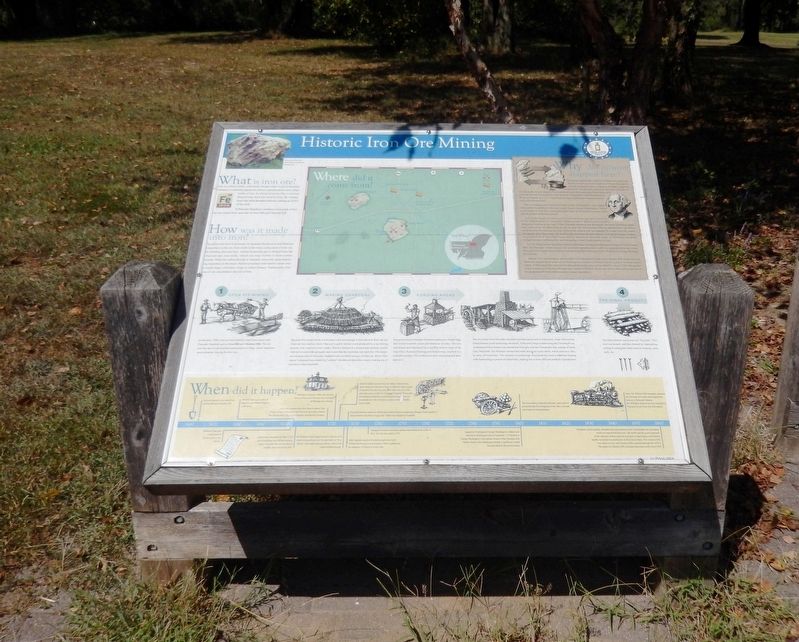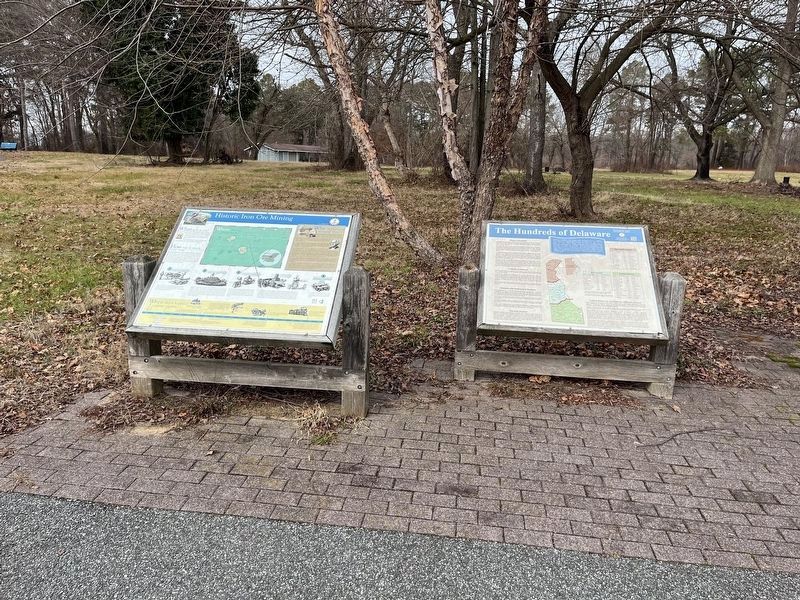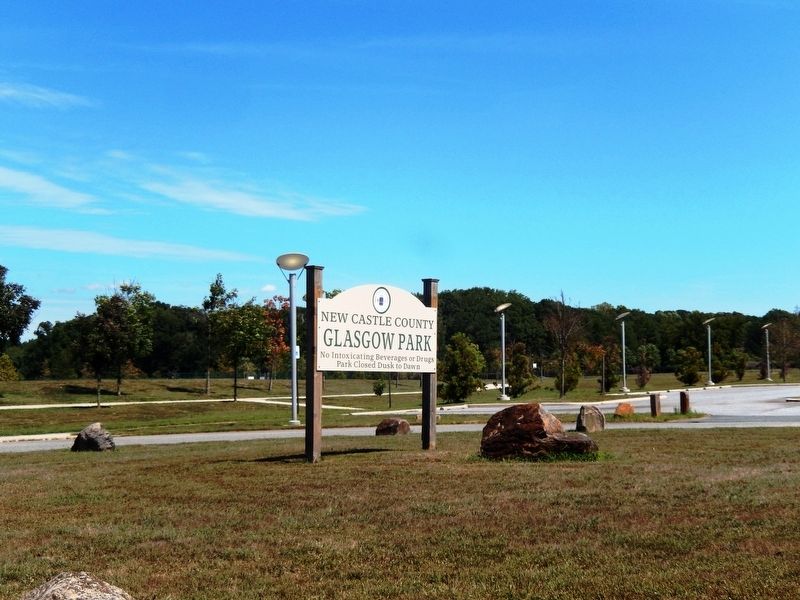Near Glasgow in New Castle County, Delaware — The American Northeast (Mid-Atlantic)
Historic Iron Ore Mining
What is iron ore?
Iron is a silvery-white, solid metal, though when found in Pencader Hundred, it commonly appears as a brown and sometimes nearly black oxide of iron. Its chemical symbol Fe, is derived from ferrum, the Latin word for iron. By volume, iron is the most abundant element, making up 34.6% of the earth.
In Pencader Hundred, a medium to low grade of iron ore was mined from open pits on Iron Hill and Chestnut Hill.
How was it made into iron?
To refine iron ore it is necessary to separate the physical and chemical impurities in the ore. Iron oxide is the main component of iron ore. By burning charcoal fuel, carbon monoxide gas is formed from the charcoal and iron oxide, which can react further to form carbon dioxide. When the carbon dioxide is released, iron (with some remaining impurities) is the result. Various processes were used to create iron: a simple forge, a bloomery forge or a blast furnace. Traditionally, four tons of ore can produce one ton of iron.
1 Open Pit Mining
In the early 1700s, iron ore was mined by hand from areas in the Pencader Hundred such as Iron Hill and Chestnut Hill. The ore was dug out of a pit and then transported to a forge, where impurities were extracted, leaving the raw iron.
2 Making Charcoal
Because fire created from wood alone is not hot enough to melt the iron from the ore, charcoal was used as a fuel. Charcoal is partly burned wood produced by a smoldering process over a period of two weeks. Wood is stacked in a mound and covered, usually with turf to control the air supply and ensure that the wood does not catch fire. The numerous chestnut trees in Pencader Hundred were excellent sources of charcoal. Most of the region's charcoal was created by "colliers" who moved about the country making use of resources where available.
3 Forging Ahead
Iron processing in Pencader Hundred employed a simple forge that would resemble a backyard barbecue of today. The iron was heated and hammered by a smith to remove most of the impurities. Repeated heating and hammering resulted in a workable product. This method was time consuming and labor intensive.
The ore mined from Penciler Hundred was later processed in a bloomery forge followed by a blast furnace as the technology advanced. A bloomery forge existed along the Christina River. A substantial blast furnace was opened at Principio near the Chesapeake Bay outside of North East, Maryland. The Principio furnace had ready access to oyster shells, which acted as a flux to carry off impurities. The advance in technology eliminated the need to alternate heating with hammering to pound out impurities, making
4 The Final Product
The final product was known as "Pig Iron". This iron was heated and then formed by hammering, rolling or casting into items such as weapons, pots, nails, etc.
Why did mining happen here?
The Great Northern War (1700-1721) between Sweden and Russia created a critical need for iron ore throughout Europe. England, a major importer of highly regarded Swedish iron was forced to look at its American colonies for its iron needs. As iron exports from Sweden slowed, the beginning of the English colonial iron industry can be traced to the creation of iron works on the Rappahannock River in Virginia in 1713.
Iron quickly became a principal component of the early colonial economy. The iron industry was the basis for the wealth of the nation's early leadership and the foundation of the new United States. George Washington's family involvement in local iron mining provided some of the wealth to pursue other significant and profitable ventures.
In Pencader Hundred, iron ore was first extracted from open pits on Iron Hill by Sir William Keith, Lt. Governor of Pennsylvania's Three Lower Counties (Delaware) starting in the early 1700s. Pencader Hundred was principally the home of mining operations. Mostly of the ore taken from the pits of Iron Hill and Chestnut Hill was transferred to operations out of the area for refining into iron. Most of the refined iron was shipped for export from the nearby Chesapeake Bay. Beginning with small batch operations the iron industry evolved into larger continuous processes involving natural energy sources and then to man-made steam. As technology advanced, a unique process combining flux and charcoal provided a better quality of iron.
In 1723 John England arrived in America and began operating the Principio Furnace in Cecil County, MD. The Principio venture was a very successful operation due in part to a corporate structure resembling one of a modern-day company. Among its board of directors were members of George Washington's family.
Also in 1723, Samuel James and investors built Abingdon Furnace near Chestnut Hill. James received financial support from some of the leading iron masters in Pennsylvania. Lack of an economical supply of flux caused the operation to fail and the works were sold at sheriff's sale in 1735. Others continued to mine ore from Iron Hill and later Chestnut Hill but, by the turn of the 20th century, the last of the proprietors William McConaughey ceased operations.
Erected by Pencader Heritage Area Association.
Topics. This historical marker is listed in this topic list: Industry & Commerce. A significant historical year for this entry is 1713.
Location. 39° 36.459′ N, 75° 43.615′ W. Marker is near Glasgow, Delaware, in New Castle County. Marker is on Route Newark. This marker is in Glasgow Park. Touch for map. Marker is at or near this postal address: 2275 Pulaski Highway, Newark DE 19702, United States of America. Touch for directions.
Other nearby markers. At least 8 other markers are within walking distance of this marker. The Hundreds of Delaware (here, next to this marker); Exploring the Past of Pencader Hundred (here, next to this marker); Mason Dixon Line & the Boundaries of Delaware (here, next to this marker); The March Through Pencader (a few steps from this marker); Delaware Militia (a few steps from this marker); Marquis de Lafayette (a few steps from this marker); In the Beginning … (approx. half a mile away); a different marker also named The March Through Pencader (approx. half a mile away). Touch for a list and map of all markers in Glasgow.
Credits. This page was last revised on December 31, 2023. It was originally submitted on September 27, 2019, by Don Morfe of Baltimore, Maryland. This page has been viewed 286 times since then and 34 times this year. Photos: 1. submitted on September 27, 2019, by Don Morfe of Baltimore, Maryland. 2. submitted on December 31, 2023, by Devry Becker Jones of Washington, District of Columbia. 3. submitted on September 27, 2019, by Don Morfe of Baltimore, Maryland. • Andrew Ruppenstein was the editor who published this page.


